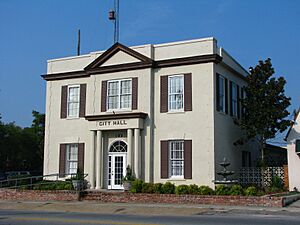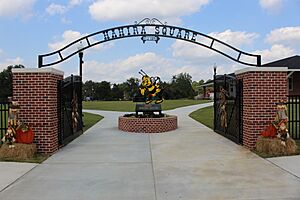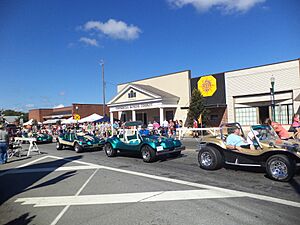Hahira, Georgia facts for kids
Quick facts for kids
Hahira, Georgia
|
|||
|---|---|---|---|

Hahira City Hall
|
|||
|
|||

Location in Lowndes County and the state of Georgia
|
|||
| Country | United States | ||
| State | Georgia | ||
| County | Lowndes | ||
| Area | |||
| • Total | 2.80 sq mi (7.26 km2) | ||
| • Land | 2.69 sq mi (6.97 km2) | ||
| • Water | 0.11 sq mi (0.29 km2) | ||
| Elevation | 225 ft (69 m) | ||
| Population
(2020)
|
|||
| • Total | 3,384 | ||
| • Density | 1,257.53/sq mi (485.48/km2) | ||
| Time zone | UTC-5 (Eastern (EST)) | ||
| • Summer (DST) | UTC-4 (EDT) | ||
| ZIP code |
31632
|
||
| Area code(s) | 229 | ||
| FIPS code | 13-36052 | ||
| GNIS feature ID | 0315009 | ||
Hahira (pronounced hay-HIGH-ruh) is a city in northwest Lowndes County, Georgia, United States. In 2020, about 3,384 people lived there. This was a big jump from 1,626 people in 2000!
Hahira has a special way of being run called a mayor-council government. This means the city is led by a mayor and four city council members. These leaders are chosen by the people who live in Hahira. As of 2023, Bruce Cain is the mayor.
You might have heard of Hahira in songs by the American singer and comedian Ray Stevens. He mentions the city in some of his tunes, especially in "Shriner's Convention."
Contents
Hahira's Interesting History
How Hahira Got Its Name
There are a few cool stories about how Hahira got its name. One legend says it was named after a cotton farm. The farm owner supposedly named his land after an African village called Hairaairee. An English traveler had told him about this village.
Another idea is that the name comes from "Pi-Hahiroth," a place in an ancient Hebrew book. A fun local story says the name came from a train engineer named Hira. His friends would call out, "Hey, Hira!" as he passed by.
Early Days and Growth
Hahira officially became a city in 1891. Henry Briggs Lawson was the first mayor and served until 1907. Before it was even a city, many people moved to the area in the mid-1880s. This led to several stores opening up.
Later, a bank opened in 1904, and a newspaper started in 1906. In the 1890s, there was only one doctor in the whole town!
Farming and New Crops
Hahira was mostly a farming community. People grew their own vegetables and raised animals like hogs and milk cows for food. The main crop they sold was cotton. But in the early 1920s, tiny bugs called Boll weevils ruined the cotton crops.
After that, farmers started growing tobacco. This was new for the area, as tobacco was usually grown in places like Virginia and North Carolina.
Cigarettes and Timber
In the late 1920s, some business people in Hahira decided to make cigarettes right there in town. This meant they didn't have to ship their tobacco far away. Their cigarette packs even showed a Native American man and a wigwam.
During the Great Depression, the company was sold. Hahira then became the place where "Happy Days" cigarettes were made for many years. The cigarette factory was next to the Norfolk Southern Railroad. It stayed open until 1998 and was torn down in 2002. Many of its old bricks and wood were saved and used again!
Timber, like large yellow pine trees, was also very important to Hahira's economy. The town even became known for boxing in the late 1920s and early 1930s!
The Rise of Beekeeping
When the first settlers came to South Georgia, there were no honeybees to help pollinate their crops. Beekeeping was brought to the area by W. L. Morgan. Different types of bees were introduced, like the black bee from Germany or Holland and the yellow bee from Italy.
J. E. Williams started a bee farm, called an apiary, near what is now Cook County. He was the first person to keep bees for business in Lowndes County. The Puett Co. and Garnett Puett Sr. are also famous for starting the beekeeping industry in Hahira.
Even today, Hahira is still a farming community. Tobacco is still grown, but not as much as it used to be.
Hahira's Location and Surroundings
Hahira is located at 30°59′26″N 83°22′17″W / 30.99056°N 83.37139°W. U.S. Route 41 goes right through the middle of town. If you go north on this road, you'll reach Cecil in about 4 miles. If you go south for about 14 miles, you'll get to Valdosta, which is the main city of the county.
Interstate 75 is a big highway that runs along the west side of Hahira. You can get on it from Exit 29 (Georgia State Route 122). I-75 goes north to Tifton (about 33 miles) and south past Valdosta to Lake City, Florida (about 74 miles).
State Route 122 is Hahira's Main Street. It goes east to Lakeland (about 18 miles) and west to Pavo (about 22 miles).
The city covers about 2.80 square miles (7.26 square kilometers). Most of this is land, but about 0.11 square miles (0.29 square kilometers) is water. Franks Creek flows through the western part of Hahira. This creek is part of a larger river system that eventually flows into the Gulf of Mexico.
Hahira's Population Over Time
| Historical population | |||
|---|---|---|---|
| Census | Pop. | %± | |
| 1900 | 365 | — | |
| 1910 | 346 | −5.2% | |
| 1920 | 401 | 15.9% | |
| 1930 | 420 | 4.7% | |
| 1940 | 537 | 27.9% | |
| 1950 | 1,010 | 88.1% | |
| 1960 | 1,297 | 28.4% | |
| 1970 | 1,363 | 5.1% | |
| 1980 | 1,534 | 12.5% | |
| 1990 | 1,353 | −11.8% | |
| 2000 | 1,626 | 20.2% | |
| 2010 | 2,737 | 68.3% | |
| 2020 | 3,384 | 23.6% | |
| U.S. Decennial Census 1850-1870 1870-1880 1890-1910 1920-1930 1940 1950 1960 1970 1980 1990 2000 2010 |
|||
In 2000, there were 1,626 people living in Hahira. There were 643 households, and 448 of these were families. About 37.9% of households had kids under 18 living there.
The people in Hahira were of different backgrounds. About 73.49% were White, and 22.32% were African American. There were also smaller groups of Native American and Asian people. About 4.43% of the population was Hispanic or Latino.
The average age in the city was 32 years old. About 29.4% of the population was under 18.
Schools in Hahira
Students in Hahira go to schools that are part of the Lowndes County School District. The schools located right in Hahira are:
- Hahira Elementary School
- Hahira Middle School
The Walter R. & Dorothy Salter Hahira Library
The South Georgia Regional Library system includes the Walter R. & Dorothy Salter Hahira Library. For many years, Hahira's public library was just a small room in City Hall with a few thousand books. It was only open on Thursday afternoons.
Then, the state of Georgia offered money to cities to help build new libraries. Hahira citizens had to decide between fixing water issues or building a library. They chose to build a library, which opened on March 12, 1989. Hahira was even known as the "Queen Bee Capital of the World" in the 1920s!
The library is named after Walter R. Salter, who was a mayor and business owner. He really wanted a library for the town. When he passed away, his wife Dorothy gave $30,000 to help make his dream come true.
The Salter Hahira Library is a friendly place. It's used by teachers and families who teach their kids at home. It's also a place where people share local stories. In 2010, the library got a big update, with $80,000 spent to make it look even better.
Famous People from Hahira
Hahira has been home to some well-known people!
- Stephen Drew, J. D. Drew, and Tim Drew: These three brothers all played professional baseball in Major League Baseball.
- Althea Garrison: She was a city councilor in Boston, Massachusetts.
- Jerry Manuel: He was a manager for Major League Baseball teams.
- Mark and Dean Mathis: These singers were part of the pop group The Newbeats. They are famous for their song "Bread and Butter."
- Gabe Nabers: He is a professional football player in the National Football League.
- Lizz Wright: She is a talented jazz singer and composer.
Fun Festivals in Hahira
Hahira Honey Bee Festival
The Hahira Honeybee Festival is a super popular event held every year in early October. It started in 1981 thanks to Mamie Sorrell and Adeline Landrum. They wanted to bring life back to Hahira with a festival full of art, crafts, food, music, a beauty pageant, and a parade.
The festival has grown a lot! It used to be just one weekend, but now it lasts a whole week. It's one of the biggest festivals of its kind in South Georgia. As many as 36,000 people come to enjoy the parade and street activities!
Each year, the festival has a special theme. For example, in 2022, it honored people with special abilities. In 2023, it honored lineworkers. For 2024, the festival will celebrate school bus drivers.
In October 2022, Georgia's Governor Brian Kemp was the first governor to lead the festival's parade!
Great Hahira Pick-In
From the early 1980s to the mid-1990s, Hahira hosted an annual bluegrass festival called the Great Hahira Pick-In. Wilby and Gloria Coleman, along with their friends and family, organized this event.
The festival featured bluegrass bands playing on a stage and musicians jamming in campsites all over the city. It was a weekend full of music! The Pick-Ins ended in the mid-1990s. However, in 2009, Harvey's Supermarket brought back a "Great Hahira Pick-In" for a short time.
See also
 In Spanish: Hahira para niños
In Spanish: Hahira para niños








